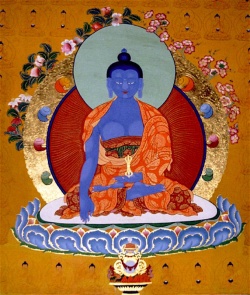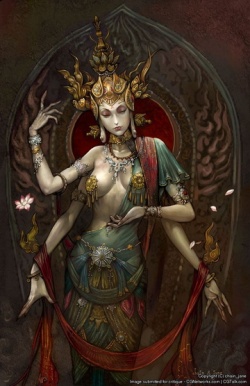The Majjhima Nikaya
The first sutta in the Majjhima Nikaya in which the Venerable Maha Kaccana plays a prominent role is the Madhupindika Sutta (MN 18), the Honeyball Discourse, a title assigned to it by the Buddha himself — perhaps a unique instance of the Buddha's conferring a title upon a sutta spoken by a disciple.
The sutta opens on an occasion when the Buddha is dwelling at the city of Kapilavatthu in his native land, the Sakyan republic. One day, while the Buddha is sitting in meditation in Nigrodha's Park, an arrogant Sakyan named Dandapani approaches him and asks him, in a deliberately discourteous tone: "What does the recluse assert, what does he proclaim?" The Buddha replies with an answer intended to underscore his own refusal to be dragged into the type of contention that his questioner wants to provoke:
"Friend, I assert and proclaim such (a teaching) that one does not quarrel with anyone in the world with its gods, its Maras and its Brahmas, in this generation with its recluses and brahmans, its princes and its people; such (a teaching) that perceptions no more underlie that brahman who abides detached from sensual pleasures, without perplexity, shorn of worry, free from craving for any kind of being."
The reply is utterly incomprehensible to Dandapani, who raises his eyebrows in bewilderment and departs. Later, in the evening, the Buddha informs the bhikkhus what had transpired. One monk inquires: "What exactly is the teaching that the Blessed One proclaims whereby one can avoid all quarrels and, at the same time, be free from the pernicious influence of craving?" The Buddha answers with the following pithy statement:
"Bhikkhus, as to the source through which perceptions and notions tinged by mental proliferation beset a person: if nothing is found there to delight in, welcome, and hold to, this is the end of the underlying tendencies to lust, aversion, views, doubt, conceit, the desire for being, and ignorance; this is the end of reliance on rods and weapons, of quarrels, brawls, disputes, recrimination, malice, and false speech; here these evil unwholesome states cease without remainder."
Having said this, before the monks even have time to ask for an explanation, the Lord rises from his seat and enters his dwelling.
After the Buddha has retired, the bhikkhus ponder his statement, and realizing that they cannot understand it on their own, they consider: "The Venerable Maha Kaccana is praised by the Teacher and esteemed by his wise companions in the holy life. He is capable of expounding the detailed meaning. Suppose we went to him and asked him the meaning of this."
When they approach Maha Kaccana and make their request, he first chides them for coming to him rather than asking the Buddha to clarify it. To come to him when the Blessed One is present, he says, is like seeking heartwood among the branches and leaves of a great tree after passing over the trunk. The Blessed One is the one who knows and sees; he is vision, he is knowledge, he has become the Dhamma, become the holy one; he is the sayer, the proclaimer, the elucidator of meaning, the giver of the Deathless, the Lord of the Dhamma, the Tathagata.
The bhikkhus, however, while admitting that the elder's reproach is warranted, still insist that he himself is able to explain the meaning. Finally the elder consents and then gives the following explanation of the Buddha's brief statement:
"Dependent on the eye and forms, eye-consciousness arises. The meeting of the three is contact. With contact as condition there is feeling. What one feels, that one perceives. What one perceives, that one thinks about. What one thinks about, that one mentally proliferates. With what one has mentally proliferated as the source, perceptions and notions tinged by mental proliferation beset a person with respect to past, future, and present forms cognizable through the eye."
The same pattern is repeated for each of the other sense bases. The elder then connects the entire exposition with the principle of conditionality, showing how each term in the series arises in dependence on the preceding term and ceases with the cessation of its predecessor.
This passage, rich in implications, offers a penetrative account of the process by which the deluded mind becomes overwhelmed by its own imaginary creations — its distorted perceptions and mental constructs. The sequence begins as a straightforward description of the conditioned genesis of cognition: each type of consciousness arises in dependence on its respective sense faculty and object. The process unfolds in the natural order through contact, feeling, and perception as far as the stage of thinking. But in the unenlightened worldling, who lacks correct insight into the true nature of things, at the stage of thought cognition is vitiated by the influence of papañca, a difficult Pali word best rendered as "conceptual proliferation."[17] Instead of correctly comprehending the objects of perception, the deluded mind, infiltrated by papañca, spins out a complex mental commentary which embellishes things with the erroneous notions of "mine," "I," and "my self." Thereby the person is overrun by "perceptions and notions tinged by mental proliferation" (papañcasaññasankha).
The underlying springs of this conceptual proliferation are three defilements: craving (tanha), conceit (mana), and wrong view (ditthi). When these three gain control of the thought process, cognition runs wild, churning up a host of delusive ideas, obsessions, and passions which overpower the subject and reduce him to their hapless victim. This process of sense perception, as Maha Kaccana shows, is "the source through which perceptions and notions tinged by mental proliferation beset a person," referred to by the Buddha in his brief statement. When there is no delighting in the process of perception by way of craving, which elaborates upon experience in terms of the notion "mine"; when there is no welcoming it by way of conceit, which introduces the notion "I am"; when there is no holding to it by way of wrong view, which proliferates in notions of a self, then all the underlying tendencies to the defilements will be uprooted, and one can dwell in the world as a liberated sage, holy and wise, without quarrels, conflicts, and disputes.
Such was the explanation of the Buddha's words that the Venerable Maha Kaccana offered to the monks. Afterwards the monks approached the Blessed One and told him what Maha Kaccana had said. The Buddha replied with words of the highest praise for his disciple: "Maha Kaccana is wise, bhikkhus, Maha Kaccana has great wisdom. If you had asked me the meaning of this, I would have explained it to you in the same way that Maha Kaccana has explained it. Such is the meaning of this, and so you should remember it."
Just then the Venerable Ananda, standing nearby, added a memorable simile to highlight the beauty of Maha Kaccana's exposition: "Just as if a man exhausted by hunger and weakness came upon a honeyball, in the course of eating it he would find a sweet delectable flavor; so too, venerable sir, any able bhikkhu, in the course of scrutinizing with wisdom the meaning of this discourse on the Dhamma, would find satisfaction and confidence of mind." On the basis of this simile the Buddha named the discourse the Madhupindika Sutta, "The Honeyball Discourse."
The other two Majjhima Nikaya suttas featuring Maha Kaccana, and one in the Anguttara Nikaya, conform to this same stereotyped pattern: the Buddha makes a brief statement, gets up, and enters his dwelling; the monks approach the Venerable Maha Kaccana to ask for an explanation of the meaning; he reprimands them for coming to him rather than asking the Lord himself, but finally he complies with their request and elucidates the Buddha's utterance; the monks return to the Buddha and repeat his analysis, which the Master applauds with words of praise for the elder.
The Maha Kaccana Bhaddekaratta Sutta (MN 133) centers around the famous Bhaddekaratta poem, a set of verses spoken by the Buddha that had been circulating within the Sangha. The poem stresses the need to abandon longing for the past and anticipation of the future; it calls instead for urgent effort to marshal one's energies for penetrating with insight the present reality itself. Many of the monks had learned the poem by heart, along with the Buddha's own exegesis of it, and had been using it as an inspiration for their meditation practice and as a theme for sermons.[18]
One bhikkhu named Samiddhi, however, did not know even the poem, let alone its exegesis. One day a benevolent deity, taking compassion on him, came to him in the early morning and urged him to learn the Bhaddekaratta poem and exposition. The Venerable Samiddhi went to the Buddha and asked him to teach him the Bhaddekaratta summary and its analysis. The Buddha recited the poem:
"Let not a person revive the past
Or on the future build his hopes,
For the past has been left behind
And the future has not been reached.
Instead with insight let him see
Each presently arisen state;
Let him know that and be sure of it,
Invincibly, unshakeably.
Today the effort must be made;
Tomorrow Death may come, who knows?
No bargain with Mortality
Can keep him and his hoards away.
But one who dwells thus ardently,
Relentlessly, by day, by night —
It is he, the Peaceful Sage has said,
Who has one fortunate attachment."
Then the Blessed One rose from his seat and entered his dwelling.
Samiddhi, and the other monks present at the time, went to the Venerable Maha Kaccana in search of an explanation. As in the prelude to the Madhupindika Sutta, Maha Kaccana at first remonstrates with them, but then agrees to share his understanding of the poem. Taking up the first two lines as the theme of his exposition, he explicates each by way of the six sense bases.
One "revives the past" when one recollects the eye and forms seen in the past, dwelling upon them with desire and lust; so too with the other five sense faculties and their objects. One "builds up hope upon the future" when one sets one's heart on experiencing in the future sense objects one has not yet encountered. One who does not bind himself by desire and lust to memories of past sensory experience and yearnings for future sensory experience is one who "does not revive the past or build up hope upon the future." Similarly, one whose mind is shackled by lust to the present sense faculties and their objects is called "one vanquished in regard to presently arisen states," while one whose mind is not bound to them by lust is called "one invincible in regard to presently arisen states."
Again, the monks return to the Buddha, who says "if you had asked me the meaning of this, I would have explained it to you in the same way that Maha Kaccana has explained it."
The third Majjhima sutta, the Uddesavibhanga Sutta (MN 138), opens with the Buddha announcing to the monks that he will teach them a summary (uddesa) and an exposition (vibhanga). He recites the summary thus:
"Bhikkhus, a bhikkhu should examine things in such a way that while he is examining them, his consciousness is not distracted and scattered externally nor stuck internally, and by not clinging he does not become agitated. If his consciousness is not distracted and scattered externally nor stuck internally, and if by not clinging he does not become agitated, then for him there is no origination of suffering — of birth, aging, and death in the future."
Then, as on prior occasions, he rises from his seat and retires, without giving the exposition — a strange omission, as he had announced that he would teach the exposition! But the monks do not feel lost, for the Venerable Maha Kaccana is in their midst, and after his usual protest, he begins his analysis.
He proceeds by taking up each phrase in the Buddha's summary and dissecting it in minute detail. How is consciousness "distracted and scattered externally"? When a monk has seen a form with the eye (or has experienced some other sense object with its corresponding faculty), "if his consciousness follows after the sign of form, is tied and shackled by gratification in the sign of form, is fettered by the fetter of gratification in the sign of form, then his consciousness is called 'distracted and scattered externally.' " But if, on seeing a form with the eye, etc., the monk does not follow after the sign of form, does not become tied and shackled to the sign of form, then his consciousness is called 'not distracted and scattered externally.' "
His mind is "stuck internally" if he attains any of the four jhanas, the meditative absorptions, and his mind becomes "tied and shackled" by gratification in the superior rapture, bliss, peace, and equanimity of the jhana. If he can attain the jhanas without becoming attached to them, his mind is "not stuck internally."
There is "agitation due to clinging" (upadaya paritassana) in the "uninstructed worldling" (assutava puthujjana), who regards his five aggregates as self. When his form, or feeling, or perception, or volitional formations, or consciousness undergoes change and deterioration, his mind becomes preoccupied with the change, and he becomes anxious, distressed, and concerned. Thus there is agitation due to clinging. But the instructed noble disciple does not regard the five aggregates as his self. Therefore, when the aggregates undergo change and transformation, his mind is not preoccupied with the change and he dwells free from anxiety, agitation, and concern.
This, the elder states, is how he understands in detail the summary stated in brief by the Blessed One, and when the monks report to the Master, he endorses his disciple's explanation.





